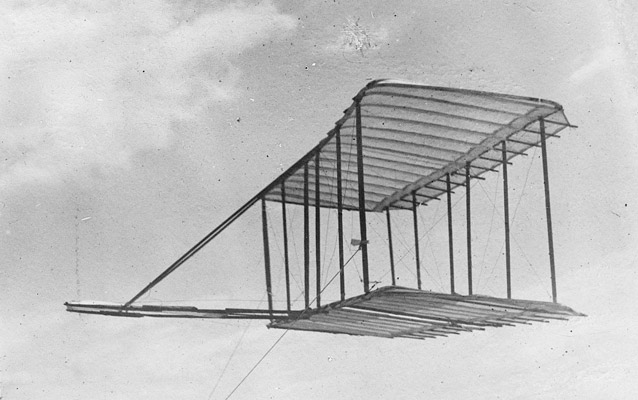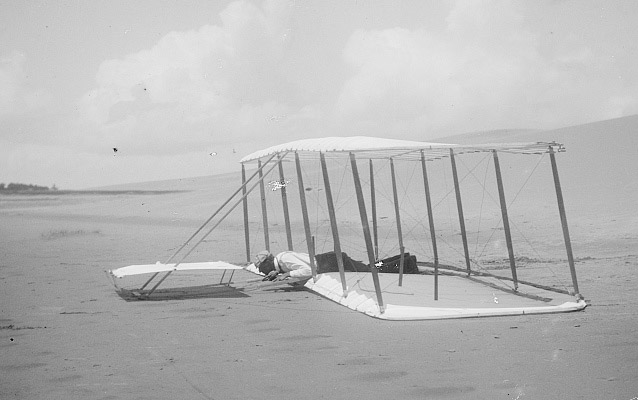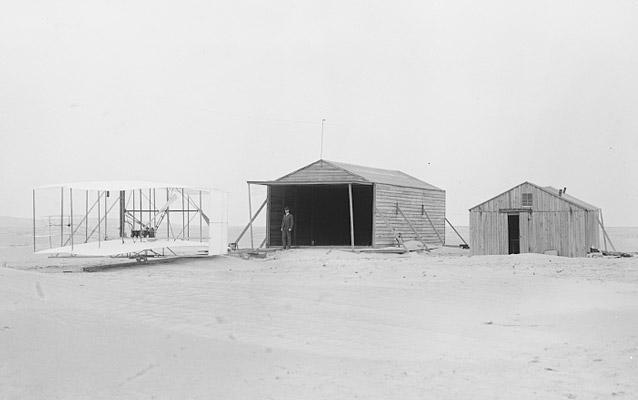Road to First Flight
After reading practically all available documentation on flight and experiments in human flight, the Wright brothers knew that the solutions to lift and propulsion needed only refining, but no one had achieved lateral control. Rejecting the principle of inherent stability - the conventional wisdom - they wanted control to depend on the pilot, like a bicycle being balanced by the rider. Wilbur developed the notion of warping the wings - sparked by his observation of birds and the idle twisting of a box - to rotate the wings and stabilize flight. While in Dayton, they tested wing-warping - the forerunner of ailerons - on a 5-foot biplane kite.
With the success of their kite however, the brothers soon realized that weather conditions in Dayton were not suitable for extensive flying experiments. They wrote the National Weather Bureau in Washington, D.C., requesting a list of places on the east coast where the winds were constant. They chose Kitty Hawk, the 6th windiest location, not only for the steady wind, but also for the soft sand, high sand dunes, and isolation. In 1900, they began their journey to Kitty Hawk, North Carolina, a journey that would forever change the world.
1900
In a letter dated May 13, 1900 to Octave Chanute, an experienced engineer and a worldwide authority on flight at the time, Wilbur Wright wrote:
For some years I have been afflicted with the belief that flight is possible to man. My disease has increased in severity and I feel that it will soon cost me an increased amount of money if not my life. I have been trying to arrange my affairs in such a way that I can devote my entire time for a few months to experiment in this field.
Confident their design was sound, the Wrights built a 17-foot glider with an unusual forward elevator. They arrived at Kitty Hawk in October hoping to gain flying experience, but the wings generated less lift than expected, and they flew the glider primarily as a kite, working the control surfaces from the ground and collecting data they could use to make their own scientific tables. Local resident Tom Tate was given some exhilarating rides on the glider/kite, while the brothers controlled it from the ground, gathering resistance data with an upright passenger. They also flew the glider with bags of sand and chains. To calculate the force of lift and drag together on the glider they put a scale, similar to a produce scale, on the kite/glider’s line. They determined the wind speed with an anemometer, calculating “the angle of the kite line to the horizontal.” They determined that the lift produced was just two-thirds that which was estimated in the Lilienthal table.

Wilbur and Orville Wright
Finally they were ready to try free gliding. Wilbur (Orville didn’t fly prior to 1902) did a dozen free flights with time in the air calculated at two minutes. After spending two weeks in Kitty Hawk in the fall of 1900, they went home somewhat discouraged, but convinced they had achieved lateral and longitudinal control.
1901
This was the year the Wrights sharpened their focus. Trying to overcome the lift problem, they increased the camber of the 1901 glider. They also lengthened its wingspan to 22 feet, its wing area to 290 square feet, and its poundage to 98 pounds, making it the largest glider anyone had attempted to fly. But at their new Kill Devil Hills camp, lift was still only a third of that predicted by the Lilienthal data upon which the wing design was based. And the glider pitched wildly, repeatedly climbing into stalls, which was, Orville stated in a letter to Katharine, “precisely the fix Lilienthal got into when he was killed.” When they returned to the earlier camber, they achieved longitudinal control and eventually glided 335 feet. But the machine was still unpredictable. When the pilot raised the left wing to initiate the expected right turn, the machine instead tended to slip to the left (adverse yaw) and spin into the ground—they dubbed this effect “well-digging.” Octave Chanute and his assistants Edward Huffaker and George Spratt, visited the camp during the 1901 season, and Chanute assured the brothers that they had achieved results that were the best ever obtained. They had also achieved the distance record for gliding. However, the failure with the wing-warping, and the realization that their work had relied on false data, brought them to the point of quitting—Wilbur expressed to Orville, that “Not within a thousand years would man ever fly.” Instead, they returned home to Dayton, built a wind tunnel, and produced their own data.

Wilbur and Orville Wright
1902
The 1902 machine embodied the Wrights' exhaustive research. They gave it efficient 32-foot wings and added vertical tails to counteract adverse yaw. The pilot moved a hip cradle to warp the wings. Some 400 glides proved the design workable, but still flawed. Still, sometimes, when the pilot tried to raise the lowered wing to come out of a turn, the machine instead slid sideways toward the wing and spun into the ground. Orville suggested a movable tail to counteract this tendency. After Wilbur thought to link the tail movement to the warping mechanism, the plane could be turned and stabilized smoothly. The Wrights saw that control and stability were related, that a plane turned by rolling. If others had thought about steering at all, it was by boat rudder - a marine analogy unworkable in the air. The elevator produces pitch (up-down movement of the nose), for longitudinal control; wing-warping (now Ailerons) produce roll (rotation of the wings), for lateral control, and the rudder produces yaw (right and left movement of the nose), for directional control. These movements in combination turn the aircraft. Six hundred more glides that year satisfied the Wright brothers that they had built the first working airplane. In 1903, they would prove it.
1903—Leading up to First Flight
The Wrights labored in relative obscurity, while the experiments of Samuel Langley of the Smithsonian Institution were followed in the press and underwritten by the War Department. Yet Langley, as others before him, had failed to achieve powered flight. They relied on brute power to keep their theoretically stable machines aloft, sending along a hapless passenger and hoping for the best. It was the Wrights' genius and vision to see that humans would have to fly their machines, that the problems of flight could not be solved from the ground. In Wilbur's words, "It is possible to fly without motors, but not without knowledge and skill." With over a thousand glides from atop Big Kill Devil Hill, the Wrights made themselves the first true pilots. These flying skills were a crucial component of their invention. Before they ever attempted powered flight, the Wright brothers were masters of the air.
While home in Dayton, they prepared for their next trip to Kitty Hawk, feeling sure they would achieve first flight. Their glider experiments on the Outer Banks of North Carolina, though frustrating at times, had led them down the path of discovery. Through those experiments, they had solved the problem of sustained lift and, most importantly, they could now control an aircraft while in flight. The brothers felt they were now ready to truly fly. But first, the Wrights had to power their aircraft. Gasoline engine technology had recently advanced to where its use in airplanes was feasible. Unable to find a suitable lightweight commercial engine, the brothers designed their own, and had Charles Taylor, a machinist that worked at their bicycle shop, build it for them. It was cruder and less powerful than Samuel Langley's, but the Wrights understood that relatively little power was needed with efficient lifting surfaces and propellers. Such propellers were not available, however. Scant relevant data could be derived from marine propeller theory. Using their air tunnel data, they designed the first efficient airplane propeller, one of their most original and purely scientific achievements.
However, there was much preparation in 1903 before they could be ready to fly. Their flyer was heavier than they thought. It had a 40-foot 4-inch wingspan with a 510-square-foot wing area, and by itself weighed 605 pounds. That weight was nearly five times more than the weight of their 1902 glider. They didn’t know if the engine would be powerful enough to lift the plane off the ground. The brothers, and their assistants, could not set the new machine in motion and cast it into the air by charging with it into the wind while keeping the wings steady anymore. Wheels would not have worked well either because of the sand. The brothers designed a new way to get the plane up to the needed speed to fly, “by riding down a 60-foot wooden monorail on a dolley with two modified bicycle hubs and another hub attached to the front of the machine.”
They returned to the Outer Banks on September 26, 1903. Once the camp buildings were reconstructed to provide more suitable living space and house the flyer, they got to work. First they added a twin-vaned rudder that was joined with the wing-warping system to the 1902 glider. Wilbur and Orville made between 180 and 210 glides with the 1902 glider to practice their flying skills while still putting together and ground testing their new Flyer. They achieved a gliding record of more than 610 feet; longest time in the air was 1 minute 12 seconds. Chanute and Spratt had returned earlier in the season to assist, but they had both departed before the first flight occurred.
By the beginning of November, the brothers had the flyer mostly ready and began trying out the engine and transmission. During one of the trials the vibration from the engine caused damage to the propellors. The propellors were sent to Dayton to be fixed, but not long after they were returned to Kitty Hawk, a propellor shaft was fractured again, forcing Orville to return to Dayton with the propellors, where he had new ones created using solid spring steel. By the time they had the new propellors back in Kitty Hawk, it was December 11. The new propellors were installed, but another accident occurred. They tested the flyer on the wooden monorail track, but they did so too fast, damaging the rudder in the process, necessitating more repairs. They used a 50-pound container of sand to see if the flyer was able to attain enough lift and, with a favorable response, they were ready to attempt powered flight.
Returning to their camp at the Kill Devil Hills, they mounted the engine on the new Flyer with double tails and elevators. The engine drove two pusher propellers with chains, one crossed to make the props rotate in opposite directions to counteract a twisting tendency in flight. A balky engine and broken propeller shaft slowed them yet again, until they were finally ready on December 14th. A coin toss determined which brother would fly first. Wilbur won the toss, but lost his chance to be the first to fly when he oversteered with the elevator after leaving the launching rail. The flyer climbed too steeply, stalled, and dove into the sand. The first flight would have to wait on yet more repairs.

Wilbur and Orville Wright
Tags
- dayton aviation heritage national historical park
- wright brothers national memorial
- wright brothers
- wright brothers national memorial
- wright flyer airplane
- flight
- airplane mechanics
- kitty hawk
- dayton aviation heritage national historical park
- aviation
- aviation history
- history of technology
- transportation history
- science history
Last updated: August 15, 2017
